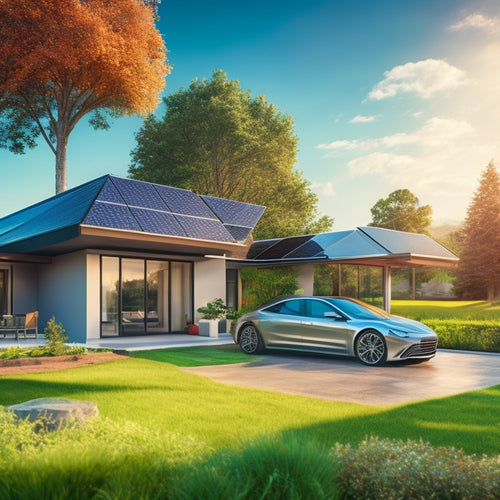
7 Best Weather-Resistant Panels for Harsh Climates
Share
When constructing in harsh climates, you require weather-resistant panels that can withstand extreme weather conditions. Look for panels that promise performance in hurricane-force winds, heavy snowfall, desert heat, and coastal saltwater corrosion. Verify they meet rigorous UV protection standards, resist impact from debris, and prevent water intrusion. Panels should also endure freezing temperatures, ice accumulation, and tropical humidity. By selecting the right weather-resistant panels, you'll guarantee the integrity and durability of your structure. Now, explore the top 7 panels that can withstand the toughest climates and find the perfect fit for your project.
Key Takeaways
• Weather-resistant panels must meet rigorous UV protection standards to prevent degradation over time in harsh climates.
• Panels should withstand hurricane-force winds exceeding 150 mph and flying debris impact through wind tunnel testing.
• Materials must be durable and resistant to corrosion, hail, and snow damage to ensure long-lasting performance in extreme weather conditions.
• Advanced water management systems and breathable membranes are crucial to prevent water absorption and mold growth in tropical and humid environments.
• Panels should be designed to withstand thermal stress, extreme temperatures, and abrasive conditions to ensure structural integrity in desert, coastal, and freezing environments.
Extreme Weather Resistance Guaranteed
When specifying exterior cladding for buildings in harsh climates, you need materials that can withstand the full fury of nature, and weather-resistant panels promise to deliver unyielding performance in the face of extreme weather conditions.
You can't just slap on any old material and expect it to hold up; you need something that's been put through the wringer – or in this case, the hurricane simulator.
To guarantee your panels can withstand the elements, look for materials that meet rigorous UV protection standards. These standards simulate the intense sunlight found in harsh climates, ensuring your panels won't degrade or discolor over time.
But that's not all – material durability testing takes it to the next level. This testing simulates the wear and tear of extreme weather conditions, including heavy rain, hail, and even debris impact.
Withstanding Hurricane-Force Winds
You need exterior cladding that can resist massive air pressure and flying debris when hurricane-force winds exceeding 150 mph strike your building. In a hurricane, the pressure difference between the inside and outside of your building can be extreme, causing walls to buckle and windows to shatter. That's why you need weather-resistant panels that can withstand the fury of the storm.
To put it to the test, manufacturers put their panels through rigorous wind tunnel testing, simulating the intense gusts and pressure fluctuations of a hurricane. But it's not just about withstanding the wind itself – it's also about resisting the impact of flying debris, like branches and roofs torn from neighboring buildings. Storm chasers would be proud of these panels' ability to keep you safe and dry.
Here are just a few reasons why these panels are the best choice for withstanding hurricane-force winds:
-
Impact resistance: Can withstand impacts from flying debris at speeds of up to 150 mph.
-
Wind tunnel tested: Proven to resist pressure differences of up to 50 pounds per square foot.
-
Air-tight seal: Prevents air leaks and water intrusion, even in extreme winds.
- Durable materials: Made with heavy-duty materials that can withstand the elements for years to come.
Snow and Hail Damage Protection
In regions prone to heavy snowfall and hailstorms, your building's exterior cladding must be engineered to withstand the relentless pounding of frozen precipitation. You can't just slap on any old panel and expect it to hold up – not if you want to avoid costly repairs or, worse, a roof collapse. That's why it's important to choose weather-resistant panels specifically designed to handle the weight and impact of snow and hail.
Roof reinforcement is key in these harsh climates. Look for panels with reinforced materials, such as impact-resistant plastics or galvanized steel, that can absorb the force of hailstones or heavy snow loads. Additionally, proper insulation is essential to prevent ice dams and water infiltration, which can lead to structural damage or mold growth. Make sure your panels have adequate insulation to keep the cold out and the warmth in.
Desert Heat and Sandstorm Endurance
Buildings in arid desert regions must be outfitted with weather-resistant panels that can withstand scorching temperatures and abrasive sandstorms that can erode exterior cladding. You don't want your building's exterior to look like the surface of Mars after a few years, do you?
To guarantee your building can brave the harsh desert environment, consider the following important factors:
-
Thermal expansion: Desert temperatures can soar up to 120°F (49°C), causing materials to expand and contract. Your panels must be able to endure this thermal stress.
-
Dust infiltration: Sandstorms can reduce visibility to near zero, and the abrasive particles can infiltrate even the tiniest crevices. Look for panels with a tight seal and a smooth, dust-repelling surface.
-
UV resistance: The intense desert sun can cause materials to degrade quickly. Choose panels that can withstand the harsh UV radiation.
- Sandstorm impact resistance: Your panels should be able to withstand the constant barrage of sand and debris during a storm.
Coastal Saltwater Corrosion Resistance
Saltwater corrosion poses a significant threat to coastal structures, requiring weather-resistant panels that can withstand the corrosive effects of salt-laden sea air and water. When considering weather-resistant panels for your coastal project, understanding the unique challenges posed by marine environments is crucial.
Galvanic reactions, which occur when two dissimilar metals come into contact in the presence of an electrolyte like seawater, can accelerate corrosion. You'll want panels that can resist these reactions and the constant exposure to saltwater and humidity.
Look for panels with a durable, marine-grade coating that can withstand the harsh conditions. A well-designed coating system should be able to prevent corrosion, even when exposed to the constant barrage of saltwater and sea air.
Additionally, consider panels with a cathodic protection system, which can help mitigate the effects of galvanic reactions. By selecting a panel that's specifically designed to withstand coastal saltwater corrosion, you can ensure your structure remains safe and secure, even in the most challenging marine environments.
Freezing Temperature and Ice Tests
You'll need weather-resistant panels that can withstand the extreme cold of freezing temperatures and the weight of ice accumulation, as structures in harsh winter climates are exposed to these conditions for extended periods. The icy grip of winter can be merciless, and only the toughest panels will survive.
Here are some key considerations for freezing temperature and ice tests:
-
Temperature: Panels must withstand temperatures as low as -40°C (-40°F) without compromising their structural integrity.
-
Ice accumulation: Panels should be able to bear the weight of ice accumulation, which can add significant pressure to the structure.
-
Thermal shock: Panels must be able to withstand rapid temperature changes, such as those experienced on frosty mornings.
- Moisture resistance: Panels should be impermeable to water and moisture to prevent ice formation and subsequent damage.
Tropical Humidity and Rain Defense
In tropical regions, where air is thick with moisture and torrential rains are frequent, your weather-resistant panels must be engineered to shield against the relentless onslaught of humidity and precipitation. You can't just slap on any old panel and expect it to hold up - not in a climate where the air is basically a warm, damp hug that never lets go.
To combat this, look for panels with advanced water management systems that prevent water absorption, reducing the risk of mold growth and structural damage. Mold prevention is key in these environments, as it can spread quickly and compromise the integrity of your panels.
A good panel should be designed to shed water quickly, with a breathable membrane that allows moisture to escape while keeping the elements out. Don't settle for anything less - your panels should be the last thing you worry about when the rain starts pouring down.
Frequently Asked Questions
Can Weather-Resistant Panels Be Used for Residential Buildings?
When building your dream home, you're wondering if weather-resistant panels are suitable for residential buildings, right? Absolutely, they can seamlessly integrate with your home's design, preserving residential aesthetics while ensuring durability and functionality, making them an excellent choice for home integration.
Are These Panels Compatible With Existing Roofing Structures?
When integrating weather-resistant panels, you'll need to assess your existing roofing structure to confirm compatibility. Conduct a thorough structural assessment to determine the feasibility of roofing integration, considering factors like load-bearing capacity and material compatibility.
How Do Weather-Resistant Panels Affect Energy Efficiency?
When you install weather-resistant panels, you'll reduce thermal bridging, preserving insulation integrity, and ultimately, your energy efficiency skyrockets - it's like wrapping your home in a cozy blanket, minus the awkwardness of actual blanket-wearing.
Do Weather-Resistant Panels Require Special Maintenance Procedures?
You'll be relieved to know that weather-resistant panels don't require extensive maintenance, but you should still clean them regularly to guarantee peak energy efficiency, especially in coastal areas where saltwater and high winds can affect material durability.
Are There Any Specific Installation Guidelines for These Panels?
When installing weather-resistant panels, you'll need to follow specific guidelines, ensuring structural reinforcements are in place and complying with local regulations to guarantee a secure and durable setup that can withstand harsh conditions.
Related Posts
-

What Solar Panels Work Best With EVS Online?
When shopping for solar panels online to power your electric vehicle, look for high-efficiency models that can withst...
-

Top Portable Solar Panels for Cars to Buy Online
When shopping for portable solar panels for your car, you'll want to take into account reputable brands like Renogy, ...
-

Safely Staying on Course: 5 Essential Lane Tips
You're about to take your driving skills to the next level by mastering the art of staying in your lane. First, inves...


